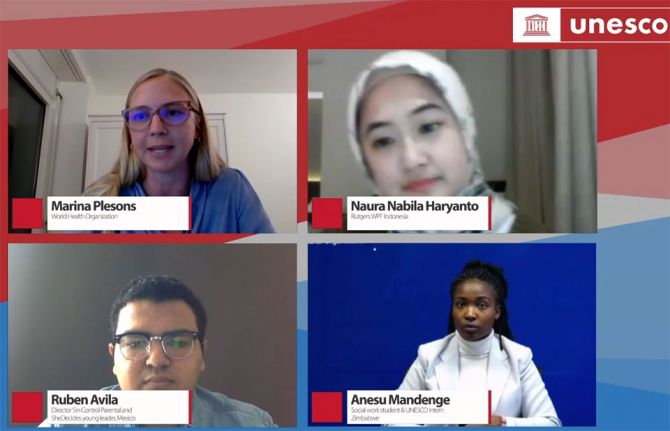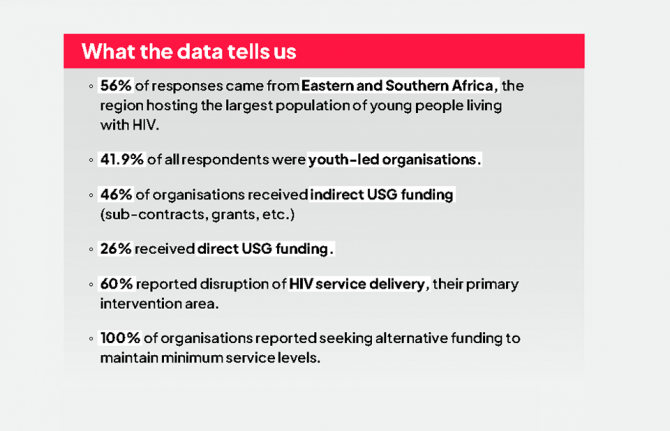

Feature Story
The journey towards comprehensive sexuality education
28 June 2021
28 June 2021 28 June 2021School-based comprehensive sexuality education plays a vital role in promoting the health and well-being of children and adolescents, both now and in their future. It improves sexual and reproductive health outcomes, including for sexually transmitted infections and HIV, promotes safe and gender equitable learning environments and improves access to and achievement in education.
In a preview of the upcoming global report on the status of comprehensive sexuality education, more than 700 people joined an online event opened by Stefania Giannini, the Assistant Director-General, Education, for the United Nations Educational, Scientific and Cultural Organization (UNESCO). While some progress has been made, she noted that there’s still a long way to go and underscored comprehensive sexuality education as one of the key priorities for action to achieve gender equality.
People attending the event heard the perspectives and recommendations of young activists for sexual and reproductive health and rights and case studies from Sweden, Tunisia and Namibia, together with engagement from policy-makers on how they are working towards ensuring quality comprehensive sexuality education for all young people.
“Like all journeys, the road towards comprehensive sexuality education is long, and sometimes winding, but it is leading us on the path to brighter, healthier futures for our young people,” Ms Giannini said.
The panel of young people collectively called for the recognition of education as a fundamental right, the need for strong implementation with proper financing and sufficient monitoring and evaluation and truly comprehensive curricula that respond to the needs of all young people.
Shannon Hader, the UNAIDS Deputy Executive Director, Programme, addressed the meeting, referring to the new Global AIDS Strategy 2021–2026 and the 2021 United Nations Political Declaration on AIDS and the importance of comprehensive sexuality education to both. “Comprehensive sexuality education is a necessary core intervention—to prevent HIV among young people and also to empower young people to recognize and address issues of violence, sexual abuse and elements of their overall sexual health and well-being. Importantly, gaps in comprehensive sexuality education knowledge are not equal. Inequalities exist based on where young people live, levels of family income or education, digital access and degrees of gender inequality in the community. The global AIDS strategy recognizes we must end inequalities to end AIDS.”
The comprehensive sexuality education global status report is a collaboration between UNESCO, UNAIDS, the United Nations Population Fund, the United Nations Children’s Fund, UN Women and the World Health Organization (WHO), with support from governments and civil society. The report provides a snapshot of the status of school-based comprehensive sexuality education around the world, which can help to inform advocacy and resourcing efforts, as governments and partners work towards the goal of ensuring that all learners receive good quality comprehensive sexuality education throughout their schooling.
“For governments and international stakeholders, we want you to stand up, speak out, change the rules and allocate resources for comprehensive sexuality education,” said Reuben Avila, the Director of Sin Control Parental and a She Decides young leader from Mexico.
The event was held in the lead-up to the Generation Equality Forum (GEF), which will be held from 30 June to 2 July and which will launch a series of concrete, ambitious and transformative actions to achieve immediate and irreversible progress towards gender equality.
”Bodily autonomy and sexual and reproductive health and rights” is one of six Action Coalitions that will be established during the GEF. Among the three actions agreed to for the Action Coalition, the first is to ”Expand comprehensive sexuality education”, with the goal of increasing the delivery of comprehensive sexuality education in and out of school to reach 50 million more children, adolescents and youth by 2026. The goal is fully supported by the Global AIDS Strategy 2021–2026, which has a target to reach 90% of all young people with comprehensive sexuality education.
“For meaningful engagement of young people, we have to make sure they have ears, eyes and teeth. The ears mean that young people are aware of their entitlements, voice means that they can advocate for these rights and entitlements to be met by duty-bearers and the teeth means that young people can hold the duty-bearers accountable for doing so,” said Marina Plesons, a technical officer on adolescent sexual and reproductive health and rights at WHO.
Related
 “Who will protect our young people?”
“Who will protect our young people?”

02 June 2025


